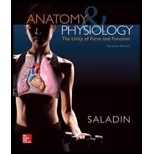
Anatomy & Physiology: The Unity of Form and Function (Standalone Book)
7th Edition
ISBN: 9780073403717
Author: Kenneth S. Saladin Dr.
Publisher: McGraw-Hill Education
expand_more
expand_more
format_list_bulleted
Concept explainers
Question
Chapter 18, Problem 1TYC
Summary Introduction
Summary:
Erythropoiesis does not correct hypoxemia, resulting from the lung cancer.
Expert Solution & Answer
Want to see the full answer?
Check out a sample textbook solution
Students have asked these similar questions
Briefly state the physical meaning of the electrocapillary equation (Lippman equation).
Explain in a small summary how:
What genetic information can be obtained from a Punnet square? What genetic information cannot be determined from a Punnet square?
Why might a Punnet Square be beneficial to understanding genetics/inheritance?
In a small summary write down:
Chapter 18 Solutions
Anatomy & Physiology: The Unity of Form and Function (Standalone Book)
Ch. 18.1 - Prob. 1BYGOCh. 18.1 - Prob. 2BYGOCh. 18.1 - Prob. 3BYGOCh. 18.1 - Prob. 4BYGOCh. 18.1 - Prob. 5BYGOCh. 18.1 - Prob. 1AYLOCh. 18.1 - Prob. 2AYLOCh. 18.1 - Prob. 3AYLOCh. 18.1 - Prob. 4AYLOCh. 18.1 - Prob. 5AYLO
Ch. 18.1 - Prob. 6AYLOCh. 18.1 - Prob. 7AYLOCh. 18.2 - Prob. 6BYGOCh. 18.2 - Prob. 7BYGOCh. 18.2 - Prob. 8BYGOCh. 18.2 - Prob. 9BYGOCh. 18.2 - Prob. 10BYGOCh. 18.2 - Prob. 11BYGOCh. 18.2 - Prob. 12BYGOCh. 18.2 - Prob. 1AYLOCh. 18.2 - Prob. 2AYLOCh. 18.2 - Prob. 3AYLOCh. 18.2 - Prob. 4AYLOCh. 18.2 - Prob. 5AYLOCh. 18.2 - Prob. 6AYLOCh. 18.2 - Prob. 7AYLOCh. 18.2 - Prob. 8AYLOCh. 18.2 - Prob. 9AYLOCh. 18.2 - Prob. 10AYLOCh. 18.2 - Prob. 11AYLOCh. 18.3 - Prob. 13BYGOCh. 18.3 - Prob. 14BYGOCh. 18.3 - Prob. 15BYGOCh. 18.3 - Prob. 16BYGOCh. 18.3 - Prob. 1AYLOCh. 18.3 - Prob. 2AYLOCh. 18.3 - Prob. 3AYLOCh. 18.3 - Prob. 4AYLOCh. 18.3 - Prob. 5AYLOCh. 18.3 - Prob. 6AYLOCh. 18.3 - Prob. 7AYLOCh. 18.4 - Prob. 17BYGOCh. 18.4 - Prob. 18BYGOCh. 18.4 - Prob. 19BYGOCh. 18.4 - Prob. 20BYGOCh. 18.4 - Prob. 21BYGOCh. 18.4 - Prob. 1AYLOCh. 18.4 - Prob. 2AYLOCh. 18.4 - Prob. 3AYLOCh. 18.4 - Prob. 4AYLOCh. 18.4 - Prob. 5AYLOCh. 18.4 - Prob. 6AYLOCh. 18.4 - Prob. 7AYLOCh. 18.5 - Prob. 22BYGOCh. 18.5 - Prob. 23BYGOCh. 18.5 - Prob. 24BYGOCh. 18.5 - Prob. 25BYGOCh. 18.5 - Prob. 26BYGOCh. 18.5 - Prob. 1AYLOCh. 18.5 - Prob. 2AYLOCh. 18.5 - Prob. 3AYLOCh. 18.5 - Prob. 4AYLOCh. 18.5 - Prob. 5AYLOCh. 18.5 - Prob. 6AYLOCh. 18.5 - Prob. 7AYLOCh. 18.5 - Prob. 8AYLOCh. 18.5 - Prob. 9AYLOCh. 18.5 - Prob. 10AYLOCh. 18.5 - Prob. 11AYLOCh. 18.5 - Prob. 12AYLOCh. 18.5 - Prob. 13AYLOCh. 18 - Antibodies belong to a class of plasma proteins...Ch. 18 - Prob. 2TYRCh. 18 - Prob. 3TYRCh. 18 - Prob. 4TYRCh. 18 - Prob. 5TYRCh. 18 - Prob. 6TYRCh. 18 - Prob. 7TYRCh. 18 - Prob. 8TYRCh. 18 - Prob. 9TYRCh. 18 - Prob. 10TYRCh. 18 - Prob. 11TYRCh. 18 - Prob. 12TYRCh. 18 - Prob. 13TYRCh. 18 - Prob. 14TYRCh. 18 - Prob. 15TYRCh. 18 - Prob. 16TYRCh. 18 - Prob. 17TYRCh. 18 - Prob. 18TYRCh. 18 - Prob. 19TYRCh. 18 - Prob. 20TYRCh. 18 - Prob. 1BYMVCh. 18 - Prob. 2BYMVCh. 18 - Prob. 3BYMVCh. 18 - Prob. 4BYMVCh. 18 - Prob. 5BYMVCh. 18 - Prob. 6BYMVCh. 18 - Prob. 7BYMVCh. 18 - Prob. 8BYMVCh. 18 - Prob. 9BYMVCh. 18 - Prob. 10BYMVCh. 18 - Prob. 1TFCh. 18 - Prob. 2TFCh. 18 - Prob. 3TFCh. 18 - Prob. 4TFCh. 18 - Prob. 5TFCh. 18 - Prob. 6TFCh. 18 - Prob. 7TFCh. 18 - Prob. 8TFCh. 18 - When RBCs die and break down, the globin moiety of...Ch. 18 - Prob. 10TFCh. 18 - Prob. 1TYCCh. 18 - Prob. 2TYCCh. 18 - Prob. 3TYCCh. 18 - Prob. 4TYCCh. 18 - Prob. 5TYC
Knowledge Booster
Learn more about
Need a deep-dive on the concept behind this application? Look no further. Learn more about this topic, biology and related others by exploring similar questions and additional content below.Similar questions
- Not part of a graded assignment, from a past midtermarrow_forwardNoggin mutation: The mouse, one of the phenotypic consequences of Noggin mutationis mispatterning of the spinal cord, in the posterior region of the mouse embryo, suchthat in the hindlimb region the more ventral fates are lost, and the dorsal Pax3 domain isexpanded. (this experiment is not in the lectures).a. Hypothesis for why: What would be your hypothesis for why the ventral fatesare lost and dorsal fates expanded? Include in your answer the words notochord,BMP, SHH and either (or both of) surface ectoderm or lateral plate mesodermarrow_forwardNot part of a graded assignment, from a past midtermarrow_forward
- Explain in a flowcharts organazing the words down below: genetics Chromosomes Inheritance DNA & Genes Mutations Proteinsarrow_forwardplease helparrow_forwardWhat does the heavy dark line along collecting duct tell us about water reabsorption in this individual at this time? What does the heavy dark line along collecting duct tell us about ADH secretion in this individual at this time?arrow_forward
arrow_back_ios
SEE MORE QUESTIONS
arrow_forward_ios
Recommended textbooks for you
 Human Physiology: From Cells to Systems (MindTap ...BiologyISBN:9781285866932Author:Lauralee SherwoodPublisher:Cengage Learning
Human Physiology: From Cells to Systems (MindTap ...BiologyISBN:9781285866932Author:Lauralee SherwoodPublisher:Cengage Learning Human Biology (MindTap Course List)BiologyISBN:9781305112100Author:Cecie Starr, Beverly McMillanPublisher:Cengage Learning
Human Biology (MindTap Course List)BiologyISBN:9781305112100Author:Cecie Starr, Beverly McMillanPublisher:Cengage Learning Comprehensive Medical Assisting: Administrative a...NursingISBN:9781305964792Author:Wilburta Q. Lindh, Carol D. Tamparo, Barbara M. Dahl, Julie Morris, Cindy CorreaPublisher:Cengage Learning
Comprehensive Medical Assisting: Administrative a...NursingISBN:9781305964792Author:Wilburta Q. Lindh, Carol D. Tamparo, Barbara M. Dahl, Julie Morris, Cindy CorreaPublisher:Cengage Learning


Human Physiology: From Cells to Systems (MindTap ...
Biology
ISBN:9781285866932
Author:Lauralee Sherwood
Publisher:Cengage Learning

Human Biology (MindTap Course List)
Biology
ISBN:9781305112100
Author:Cecie Starr, Beverly McMillan
Publisher:Cengage Learning


Comprehensive Medical Assisting: Administrative a...
Nursing
ISBN:9781305964792
Author:Wilburta Q. Lindh, Carol D. Tamparo, Barbara M. Dahl, Julie Morris, Cindy Correa
Publisher:Cengage Learning

The Cell Cycle and its Regulation; Author: Professor Dave Explains;https://www.youtube.com/watch?v=eqJqhA8HSJ0;License: Standard YouTube License, CC-BY
Cell Division - Mitosis and Meiosis - GCSE Biology (9-1); Author: Mr Exham Biology;https://www.youtube.com/watch?v=w7vp_uRA8kw;License: Standard YouTube License, CC-BY